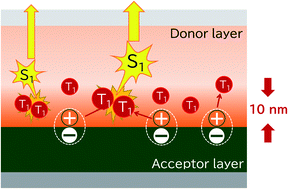Spatial distribution of triplet excitons formed from charge transfer states at the donor/acceptor interface†
Abstract
Triplet exciton formation at an organic semiconductor interface plays a crucial role in photophysical processes in electronic devices, such as organic light-emitting diodes (OLEDs) and organic photovoltaics, and in optical functions, such as photon upconversion (PUC) based on triplet–triplet annihilation (TTA), which produces a photon with high energy combining two photons with low energy. Herein, we report the spatial distribution of the triplet exciton generated after charge recombination at the organic semiconductor interface. The triplet exciton distribution is assessed by examining the variation in TTA emission when the triplet quencher is doped near the interface in the OLED and PUC systems. The obtained result indicates that 90% of the triplet excitons are confined to less than 10 nm from the donor/acceptor interface, where charge recombination occurs and a charge transfer state forms, which is a precursor of the triplet exciton. The confinement of triplet excitons leads to efficient TTA emission, whose efficiency is triplet concentration-dependent, in OLED and PUC systems utilizing the mechanism of interfacial triplet formation.

- This article is part of the themed collection: Journal of Materials Chemistry A Emerging Investigators


 Please wait while we load your content...
Please wait while we load your content...